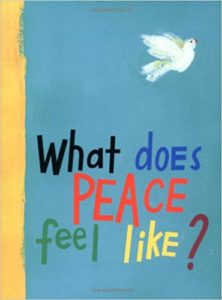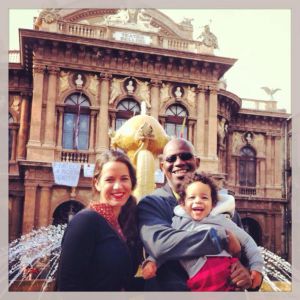 Lately adversity hammered the world in many directions: natural disasters of biblical scale, political confrontations that resulted in death and, most recently a madman mowed down more than five hundred innocent people. At some level, it feels like our world verges on the brink of collapse. Children hear and observe what occurs around them. They watch TV and absorb the horrific reports. As adults we bear a huge responsibility to help them frame and understand the facts. We must share age-appropriate information and provide them tools to process and live with the challenging realities all around us. More importantly, we must help them regain a feeling of security and peace.
Lately adversity hammered the world in many directions: natural disasters of biblical scale, political confrontations that resulted in death and, most recently a madman mowed down more than five hundred innocent people. At some level, it feels like our world verges on the brink of collapse. Children hear and observe what occurs around them. They watch TV and absorb the horrific reports. As adults we bear a huge responsibility to help them frame and understand the facts. We must share age-appropriate information and provide them tools to process and live with the challenging realities all around us. More importantly, we must help them regain a feeling of security and peace.
[bctt tweet=” Provide kids tools to process the challenging realities & help them regain a feeling of security and peace. #FamilyOfMan” username=”GayleHSwift”]
We best cope with feelings of overwhelm when we engage in action. Today’s book offers one tool that can help kids access that feeling of self-empowerment. V. Radunsky in collaboration with hundreds of children whom he interviewed from all over the planet and asked them this seminal question: What Does Peace Feel Like? Radunsky arranged their responses by senses: sight, sound, taste, touch and, smell. He illustrated the text with child-like drawings in rich, intense colors and simple shapes. The children’s words drive this book.
Parents and teachers can ask their children (students,) for their own ideas which can be made into a personalized book. Working in a group helps children notice the commonalities which all human beings share in addition to the unique perspective which each person takes on these common experiences and emotions. The more that we see one another as “like” ourselves, the less apt we are to view them as “other.” This tends to increase empathy, tolerance and, inclusivity–all of which are good. Unless we choose to live together in harmony, the future is bleak. [bctt tweet=”We must hold difficult conversations, explore complex issues & commit to a solution with which we can all live. ” username=”GayleHSwift”]
 Adoption-attuned* Lens This story can offer another pathways to exploring the role of “othering” and how it shapes relationships. People can separate themselves along many criteria, for example, nationality, religion, and politics. For children, family tends to be the main focus of their “world.” Thus distinctions about family can divide them into separate groups: divorced or intact, bio or adopted, step- or full, one parent or two, etc. Open conversations that can help kids see that these distinctions need not be used to isolate or create a sense of hierarchy in which one type of family is seen as “better” than the other.
Adoption-attuned* Lens This story can offer another pathways to exploring the role of “othering” and how it shapes relationships. People can separate themselves along many criteria, for example, nationality, religion, and politics. For children, family tends to be the main focus of their “world.” Thus distinctions about family can divide them into separate groups: divorced or intact, bio or adopted, step- or full, one parent or two, etc. Open conversations that can help kids see that these distinctions need not be used to isolate or create a sense of hierarchy in which one type of family is seen as “better” than the other.
[bctt tweet=”The more we see one another as “like” ourselves, the less apt we are to view them as “other.” This builds empathy, tolerance & inclusivity. ” username=”GayleHSwift”]
Our theme for this #DiverseKidLit is #ownvoices. The #ownvoices hashtag was created to draw attention to diverse authors and illustrators who are creating books that honor their own heritage and experiences. (As always, the theme is only a suggestion. Diverse posts on alternate topics are always welcome.)
What Is #DiverseKidLit?
Diverse Children’s Books is a book-sharing meme designed to promote the reading and writing of children’s books that feature diverse characters. This community embraces all kinds of diversity including (and certainly not limited to) diverse, inclusive, multicultural, and global books for children of all backgrounds.
We encourage everyone who shares to support this blogging community by visiting and leaving comments for at least three others. Please also consider following the hosts on at least one of their social media outlets. Spread the word using #diversekidlit and/or adding our button to your site and your diverse posts.

We hope this community serves as a resource for parents, teachers, librarians, publishers, and authors! Our next linkup will be Saturday, November 4th and the first Saturday of each month.
Upcoming Theme
Themes are a suggestion only; all diverse book posts are welcome. Do you have a suggestion for a future theme? Share your ideas with us at katie at thelogonauts dot com.
Most Clicked Post from Last Time
The most-clicked post from the previous #diversekidlit was Myra’s linkup post about Remembering Auschwitz through a picture book and a graphic novel. This post shares two powerful resources about the Holocaust in general, and Auschwitz specifically, as well as links to other sources. Thank you for sharing, Myra.
Welcome, Bethany!
#diversekidlit is excited to welcome new host, Bethany, of Biracial Bookworms. Bethany is an educator, blogger, world traveler, wife, and mom to two wonderful girls who inspired her web site. You can read more about her and her family here. We are thrilled to have Bethany joining our community as a host and advocate! Please follow here online: Blog / Twitter / Facebook / Pinterest / Instagram / Goodreads.
#DiverseKidLit is Hosted by:
an online bookstore for South Asian children’s books, toys and games
Blog / Twitter / Facebook / Pinterest / Instagram
Want to be notified when the next #diversekidlit linkup goes live? Click here to join the mailing list. Interested in joining as a host or an occasional co-host? Contact katie at thelogonauts.com.
(Never participated in a linkup before? Please click here for a more detailed step-by-step.)
Get #DiverseKidLit Recommendations on Pinterest!
Our Pinterest board highlights a wide range of amazing posts and resources for Diverse Children’s Books. Please consider following the board for even more great books!
Share Your Link Below





Gayle, I really enjoyed your post. Thank you for these suggestions. I’m visiting from the #diversekidlit link up.
Kathleen, I am glad that you found it interesting!
Enjoyed your post on peace. Timely topic for children as we see so much divisiveness.
Patricia:
I agree. We must learn to see our commonalities and not let our deifferences divide us.
Comments are closed.